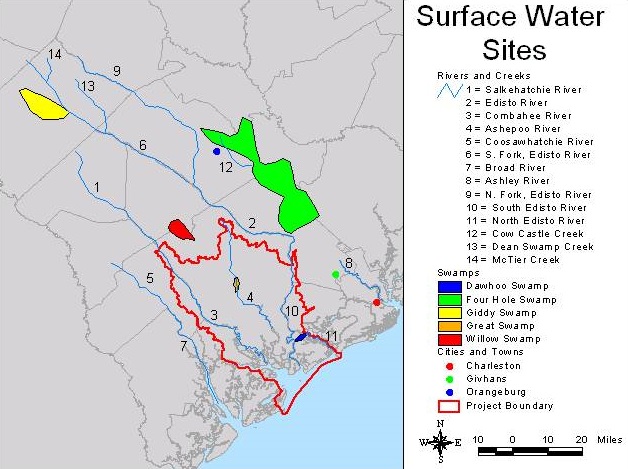Characterization of the Ashepoo-Combahee-Edisto (ACE) Basin, South Carolina
Water Quality
Water quality of a system may be affected by natural events such as tides and hurricanes, as well as anthropogenic factors such as point and nonpoint source inputs. The Clean Water Act requires the U.S. Environmental Protection Agency (USEPA) to establish criteria guidelines for use by states (i.e. S.C. Department of Health and Environmental Control in South Carolina) in preserving designated uses of lakes, streams, and rivers within their states. The South Carolina Department of Health and Environmental Control (SCDHEC) has established water quality standards required to meet beneficial uses (e.g., drinking water, recreational use, support of aquatic life). SCDHEC has been taking periodic measurements at numerous stations in the ACE Basin for over 14 years. Water quality variables measured in the ACE Basin are pH, conductivity, salinity, temperature, dissolved oxygen (DO), turbidity, fecal coliform bacteria, nitrogen, phosphorus, and biological and chemical oxygen demand.
There are a total of 13 National Pollutant Discharge Elimination System (NPDES) permit holders within the study area. By comparison, Charleston County e City of Walterboro wastewater treatment facility on the Ashepoo River (35 mi, or 56 km, inland); the Yemassee wastewater treatment facility on the Combahee River (28 mi, or 48.3 km, inland); the South Carolina Electric & Gas Canadys power station on the Edisto River (36 mi, or 57.6 km, inland); and the CCX Fiberglass Products plant in Walterboro on the Ashepoo River (28 mi, or 48.3 km, inland). Major nonpoint sources in the ACE Basin include agriculture, forestry, construction, urban development, and mining facilities.

Eleven primary and secondary SCDHEC monitoring stations (located on the Combahee, Ashepoo, S. Edisto, N. Edisto, and Coosaw Rivers) were evaluated and found to be in compliance with dissolved oxygen standards over 90% of the time, except for two stations on the Ashepoo River and two of the three stations on the Combahee River. The rate of noncompliance at the 53 sites in regard to fecal coliform ranged from 0% to 97%. The Ashepoo River downstream of Walterboro had the highest rates of noncompliance. Average fecal coliform concentrations at this station were also the highest within the study area. The Big Bay and Fishing Creek estuaries located adjacent to the town of Edisto Beach also exhibited high rates of fecal coliform noncompliance. Significant increasing trends in fecal concentrations were found at Coosaw River stations near Beaufort, and Back Bay and Fishing Creek stations near Edisto Beach. All areas exhibiting high rates of noncompliance were associated with urban development.
Concentrations of nitrates/nitrites and phosphorus have generally been stable or have decreased from 1985 to 1995. Only one (S. Edisto River at Jacksonboro) of the eleven stations evaluated for nitrate-nitrite concentrations displayed excursion rates exceeding 10% of recommended values; the concentrations at the other stations averaged less than 0.2 mg/l. Concentrations of phosphorus commonly exceeded levels recommended to prevent eutrophication at nine of the eleven monitoring stations. Rich natural deposits of phosphorus throughout the ACE Basin study area contribute to the high concentrations of phosphorus. Decreasing trends in nitrate-nitrite and phosphorus concentrations were noted at most stations. The decreasing trends in nutrients may be related to decreased agricultural activity and point-source pollution control measures, but best management practices for agriculture and forest industries may also help control nutrient runoff if accepted on a broad scale.
The South Carolina Department of Natural Resources (SCDNR) has been collecting continuous (i.e. every half-hour) water quality data at two sites in the National Estuarine Research Reserve (NERR) portion of the ACE Basin since 1995. The SCDNR sampling has found that estuarine water quality naturally varies on many spatial scales (e.g., by region, by creek) and temporal scales (e.g., tidal, diurnal, lunar, seasonal, annual). In general, water quality within the ACE Basin NERR met or exceeded standards. Oxygen levels, however, were depressed below levels known to cause biological effects for brief periods.
Current water quality issues within the ACE Basin project area are primarily related to urbanization as evidenced by excursions around developed areas within the study area. With increasing urbanization, water quality in the ACE Basin may decline unless sound management principles are applied.
